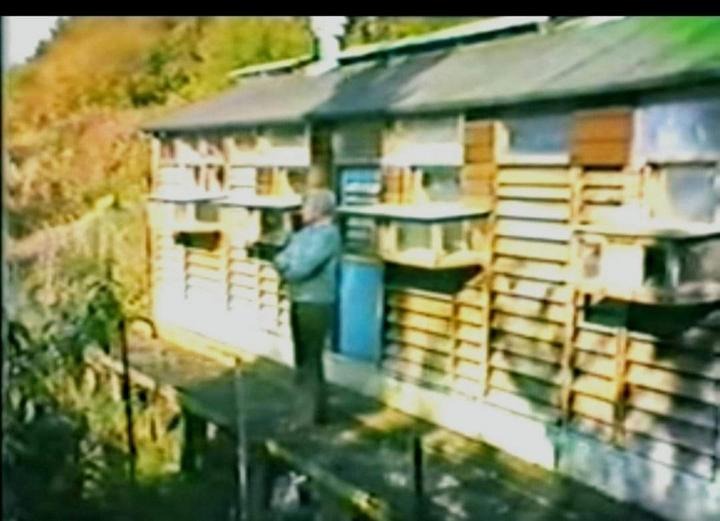Arthur & Billy Walkingshaw
The Partnership of Arthur Walkingshaw & Son - Marathon Pigeons Breeders & Racers
- Steve O'Dea
- January 7, 2022
- 4:57 pm
Watch, Listen or Read about Walkingshaw Pigeons below here....
A. Walkingshaw and Son.
Walkingshaw and Son. were based in Killyleagh, County Down, Ireland, on the shores of Strangford Lough, and flew their birds from the aptly named Sunville lofts which enjoyed an elevated position above the town. The 4 compartment loft was South Eastern facing and enjoyed the heat of the sun for most of the day in the spring and summer months, a factor enjoyed by the partnership and which they reckoned to assist with bringing birds into form before the long tests of the France to Ireland races.
The partnership, founded in 1930, originally consisted of Brothers, Arthur and James Walkinshaw , but following James’s death, Arthur’s son Billy joined him and contributed wholly into making this strain of birds such a well known performance pigeon family throughout Ireland and the UK.

Arthur had lived and worked in Workindon, Cumbria for a number of years – where he also originally kept pigeons. During his stay there, he met the famous Scottish flyer, John Kirkpatrick, from whom he attained pigeons. These were the best of the Kirkpatrick pigeons which were already making a huge name for themselves at the distance from racepoints throughout the UK and France. These Kirkpatrick pigeons were combined with Arthurs original family of Barker-Gits, to produce what we now refer to as the Walkingshaw strain of pigeons.
 “These Kirkpatrick pigeons were combined with Arthurs original family of Barker-Gits, to produce what we now refer to as the Walkingshaw strain of pigeons”
“These Kirkpatrick pigeons were combined with Arthurs original family of Barker-Gits, to produce what we now refer to as the Walkingshaw strain of pigeons”
There has been much debate about the background breeding of the Walkinshaw Birds. The “trademark” colour of “Ash” as it is known in Ireland, or “Silver” as it is mostly referred to in the UK is almost unique in modern breeds to both the Walkingshaw and Barker strains – and many other families were based on “an Old Ash Hen” which were preferred above all else for the stock-loft ! Typically the birds were normally paired in March and only birds that had flown France were allowed to hatch eggs at the Walkinshaw lofts, but when you see the performances below, you will realise that this still constituted a large number of pigeons at the lofts !
The Dam of the Loft was a 1956, Red Kirkpatrick hen who had flown 15th Open Les Sables (570 miles). She was paired to a Barker pigeon, a son of which flew Les Sables three times in the prizes and from Nantes twice. She also had a daughter known as “The Barcelona hen”, who was the 34th bird recorded from Barcelona, and only the second ever to be recorded into Ireland from this famed and difficult race point, flying 972 miles. She also had another daughter who flew 2nd Open Les Sables which was almost 600 miles to the loft. The Sire of the Loft was a cock who had flown 2nd Open Dinard at 550 miles. This pairing essentially formed the base of the loft for the next 40 years or so. From early on, It was evident that these pigeons like to be jumped in distance and that it didn’t affect their ability to get home. Typically, they would have had one cross-channel race of approximately 180 miles before being sent to France for their main race of the year.
 “…who was the 34th bird recorded from Barcelona, and only the second ever to be recorded into Ireland from this famed and difficult race point…”
“…who was the 34th bird recorded from Barcelona, and only the second ever to be recorded into Ireland from this famed and difficult race point…”
Following the deaths of the Walkingshaw family the birds were dispersed far and wide and can be found the length and breadth of not just our Island, but also in the UK. They have played an important and significant part in the genetic makeup of the Irish sea racing pigeons over the course of many years, and it is few lofts that would not mention the existence of a Walkingshaw bird in their stock loft, supporting and contributing to the creation of their next cross-sea competitors.
As for the selection of birds – this took place over a period of 40 years and consists solely of the survivors from races that were across the water from either UK or French Race points. They have been crossed with other families such as Buschaert, Delbars, Theelans, Kenyons and others to form magnificent families of birds which have stood the test of time.
One of the more famous Birds was Portavogie Lass. She was raced by Palmer and Young of Portavogie, Co. Down. She won the 1996 Miller Gold Cup being the only bird on the day from France. She was a pure Walkingshaw. Other birds with Portavogie Lass connections was a daughter, named “Glenhill Lass” who won first Open from France and a daughter of hers called “No Problem” who had 11 firsts including first Club, Fourth Open from Picauville and 1st Club, 26th Open from the Portland National. “Moonlight Lass”, another daughter of Portavogie Lass was also 1st Open from Messac. Other notable achievements with Walkingshaw birds was a bird called “Steady and True”, who was a 1956 rung Blue cock, who had been to Redon in the prizes twice at 550 miles and twice to Les Sables at 572 miles, his dam was a pigeon called “Gallant” and she had flown three Kings cups in the prizes, all at 500+ miles.
 “One of the more famous Birds was Portavogie Lass. She was raced by Palmer and Young of Portavogie, Co. Down. She won the 1996 Miller Gold Cup being the only bird on the day from France”
“One of the more famous Birds was Portavogie Lass. She was raced by Palmer and Young of Portavogie, Co. Down. She won the 1996 Miller Gold Cup being the only bird on the day from France”
There was also a 1957 Blue Cheq. hen who was 2nd Open in the King’s Cup which had also flown Redon and Les Sables. Her sire and Dam had both flown 2 Kings Cups also. There was a blue 1950 hen who had been to Rennes once, Redon twice and had recorded 29th, 34th and 60th Open in those races. In 1965 the national open race from Les Sables, there was only seven Birds home from the race. Two of these birds were flown by the Walkingshaw partnership. These French racing points, proved to be the ultimate test for many of these pigeons and some of the more significant results and performers from the family were uncovered by these marathon tests. There was the “Old Blue Cock” who flew in the prizes from France five times. In 1966, the partnership flew the Dinard race and recorded 1st, 2nd, 4th and 10th section as well as 2nd & 23rd Open in 1969. In 1958, they flew Les Sables in 2nd, 3rd and 15th Open positions.
In the early 1990s, following the clearance sale of the Walkinshaw Birds, it was known that Billy Walkinshaw had held onto a few “old favourites”. One evening, within a few weeks, one of these Old favourites disappeared from the loft. Not wanting to lose any more of these birds, he decided to part with these last few pigeons of the strain he and father had painstakingly built over a 50 year period. He turned to his friends the Murphy Brothers at Killyleagh. He brought them 2 Cocks and a Hen, with the sentiments that is he ever wanted to get the heart of his pigeon genetics back again, that they would be in easy reach. These 3 Birds went on to found another great distance family for the Murphy Brothers which endures to this day. They, in turn, have bred many birds to go and score from the channel and French Races not just for themselves, but for many other famous fanciers in Northern Ireland.
 “These French racing points, proved to be the ultimate test for many of these pigeons and some of the more significant results and performers from the family were uncovered by these marathon tests.”
“These French racing points, proved to be the ultimate test for many of these pigeons and some of the more significant results and performers from the family were uncovered by these marathon tests.”
The legacy of the Walkingshaw strain of pigeons is that of tenacity, great orientating ability and an ability to contribute to an already proven family of pigeons. They work best on the worst of days, when the speeds are below 1000 ypm, and better again if the speeds are below 700 ypm ! With their trademark classical looks of large wattles, great eyesign, good feathering and colours which sometime immediately denotes their heritage, the Walkingshaws will be around to compete for sometime yet.
